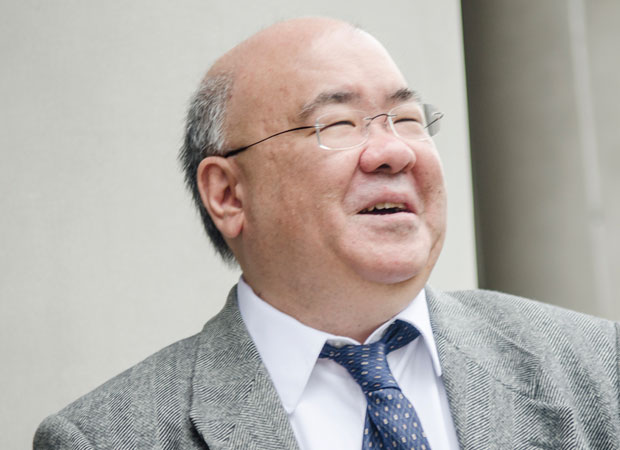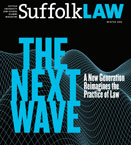
Can the Targeted Get Justice?
David Yamada's legislation fights workplace harassment
By Rachel Slade / Photo by Mark Wilson
Professor David Yamada is known on campus as an authority on workplace bullying, as well as for his Hawaiian shirts. The latter have been standard Yamada attire since he joined the Suffolk Law faculty in 1994, but they still produce cognitive dissonance on this April day in a Sargent Hall classroom—where you don’t expect to see banana tree fronds and longboats fighting the Pacific surf.
You can hear Yamada’s Midwestern roots in his Indiana accent and choice of expletives (“holy smokes,” “oh my gosh”), so what’s up with his sartorial choice? He wears the shirts to remind himself of his family’s Pacific roots.
But the prints may serve a deeper purpose as well: With those Hawaiian shirts, Yamada announces his outsider status loud and proud. Being different has shaped his work since he first joined Suffolk’s faculty 22 years ago. As a Japanese-American from outside New England, Yamada found himself an instant outsider, a status that afforded him a unique view of workplace culture in academia and beyond. He saw and heard things insiders might not, and empathized with those who were marginalized by exclusionary environments.
When he stumbled on an online interview with social psychologists Gary and Ruth Namie in 1999, Yamada found his calling. The Namies were among the first American researchers to address what they called workplace bullying, a phenomenon they describe as “health-harming mistreatment” of an employee (and sometimes of an employer) that includes “threatening, humiliating or intimidating” conduct, sabotage, or verbal abuse. Their research explores the psychological roots and consequences of such behavior. But Yamada was most intrigued by the lack of legal recourse for the targets, and that’s the focus of today’s lecture.
On this April afternoon, Yamada stands in front of two dozen second- and third-year law students to talk about workplace bullying. But first, he asks the class to think about the risk scenarios of workplace violence in a university—unhappy students packing weapons, violent people walking into buildings off the street, or even angry faculty, such as Amy Bishop, a biology professor at the University of Alabama who killed three co-workers during a faculty meeting in 2010.
“What happens if you’re harmed at work?” he asks the class. OSHA guidelines were designed to reduce the risk of workplace injury through safety education, good lighting, guards and other preventative measures. But if an employee does become a victim of violence, it’s not easy to sue the employer.
“What gets in the way?” Yamada asks.
A student speaks up: “Worker’s comp.”
Right. “If you’re slugged by a co-worker, you could go to a lawyer and sue the employer, but in most states, you wouldn’t be able to do that,” Yamada says. “In most states, you’d be limited to worker’s comp remedies. It’s a no-fault insurance system that provides benefits for those who have been injured on the job. For the most part, worker’s comp has superseded the tort law system.”
The class already knows that it probably wouldn’t be worth suing the violent co-worker because he or she wouldn’t have deep enough pockets to make a lawsuit worthwhile. You could take action based on race or sex, “but it’s a loosey-goosey collection of liability laws as to where workplace violence fits into the picture,” says Yamada.
Yamada’s point is that even if an employee is physically injured by a violent act, U.S. law doesn’t make it easy to seek a claim.
If the injury is on the inside—that is, if an employee is a target of relentless emotional abuse—finding protection under the law is exponentially more difficult. “I looked at instances when employees looked to sue employers for intentional infliction of emotional distress, that’s the obvious tort claim,” Yamada says. “I looked at hundreds of cases. When the cases weren’t dismissed outright, the courts just hated those claims. I don’t care how bad the cases were, the courts just said, ‘We don’t want to mess with workplace stuff like this. It’s not discrimination, it’s not harassment, what we believe to be emotional distress.’ Many states, including Massachusetts, have used workers’ comp to preempt these claims.”
Yamada emphasizes the difference between incivility and abusive behavior. “Workplace bullying is repeated, malicious, health-harming behavior. Not a bad day in the office or a dust-up. It’s about intentional harm and targeted victims.” He rattles off a list of bullying methods: withholding resources/information; exclusion/ostracizing; sabotage/defamation; excessively criticism; unreasonably heavy workloads designed to make the employee fail.
He asks the students to think of prominent people who have a reputation for abusing employees. One suggests Michael Scott in the TV show The Office. But Yamada wants real-life examples, and students tick off the names of notorious bosses, from Naomi Campbell to Steve Jobs.
Researchers estimate that one-third of the nation’s workforce have been a target at some point during their careers—but unlike most countries in Europe and South America, we lack laws to address the phenomenon. In 2000, Yamada wrote a lengthy law review article about how American law doesn’t apply. Since then, he’s worked on proposed legislation, called the Healthy Workplace Bill, that gives severely bullied workers a legal claim of action and creates legal incentives for employers to engage in prevention of and response to workplace bullying. Modeled after the sexual harassment terms under Title VII, the legislation doesn’t make it easy to sue. “I set the bar higher for recovery—you need to show intent to harm,” Yamada says. “We need to open this door carefully.”
State Representative Danielle W. Gregoire JD ’06, a former student of Yamada’s, says that his work on policy in the workplace has had a ripple effect across the country and in Massachusetts. “It was at his urging that I co-sponsored his legislation to ban workplace bullying, and I’m happy to continue our work together to see this bill become law so we can better protect Bay State employees and make their lives better,” Gregoire says. Variations on Yamada’s legislation have been introduced in 30 states, and he’s optimistic that support is growing. As students pack up their notes, Yamada says, “Maybe this is something whose time has come.”





